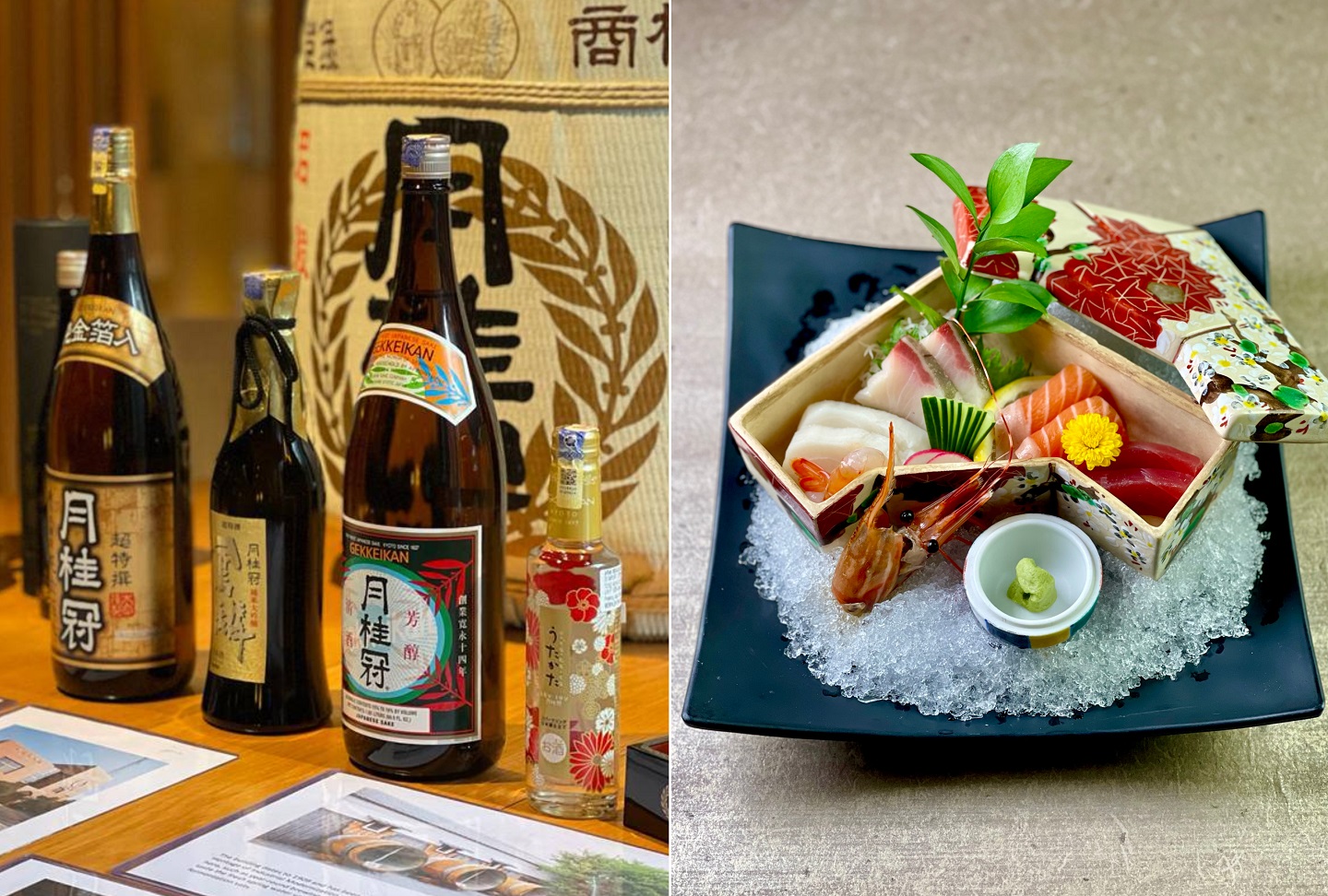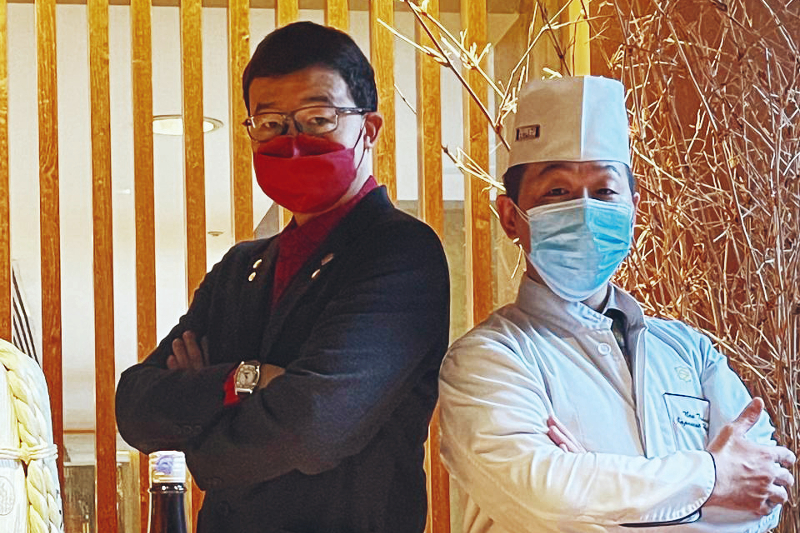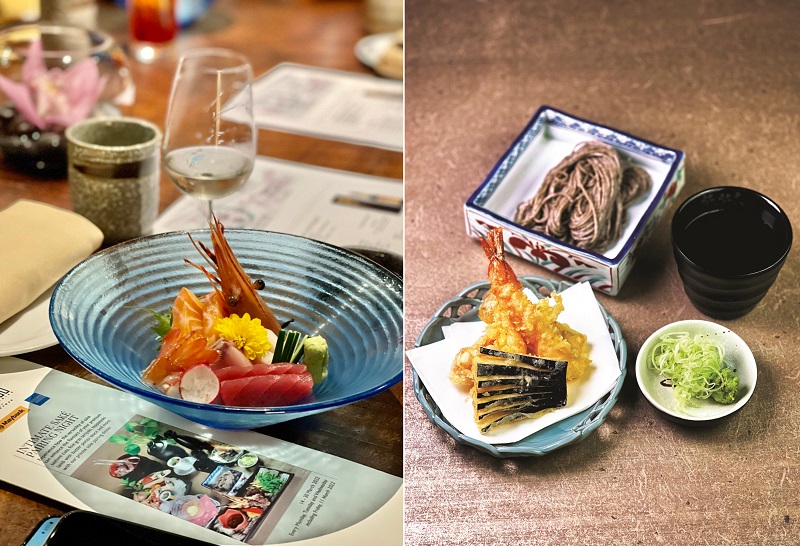
Zipangu’s Japanese Saké Pairing Dinner features four Gekkeikan sakés (All photos: Shangri-La Kuala Lumpur)
While the seafood buffet at Lemon Garden is usually the first port of call for non-hotel guests visiting Shangri-La Kuala Lumpur, its Japanese restaurant Zipangu offers a more intimate environment, with a view of a manicured Zen garden and an excellent alcohol selection to boot. Before being escorted to their tables, guests are led through a visually impressive floor-to-ceiling walk-in wine and saké cellar. Hundreds of bottles balancing on metal rods — making it seem almost as if they are levitating — flank both sides, prompting diners to stop and stare or inch closer for a better look at the labels. It was a suitable reception that foreshadowed the line-up of stellar sakés at a recent pairing dinner we attended.
The five-course dinner was a collaborative effort between the restaurant’s Japanese head chef Nao Takeshita and master saké sommelier Danny Leong. Takeshita presented a variety of traditional fare injected with a touch of contemporary finesse and Leong paired those dishes with sakés from Gekkeikan Saké Brewery, one of the largest and oldest in the world.
0_-chef_danny.jpg

Gekkeikan is responsible for about 20% of global saké exports. Founded 385 years ago in Fushimi, Kyoto, its predecessor Kasagiya (named after founder Jiemon Okura’s birthplace in Kasagi) harnessed the trading town’s pristine spring waters to produce saké to be sold to locals. It wasn’t until the beginning of the 20th century, under the enterprising 11th-generation head Tsunekichi Okura, that Kasagiya began to ship nationwide. It also renamed itself Gekkeikan — meaning victory and merit — and opened a research institute to look into scientific techniques and advances to brewing technology.
While barrelled production was at its peak, Gekkeikan pushed for bottling and became the forerunner of its commercialisation. It continued to transcend boundaries, including developing saké without preservatives and using dark bottles to prevent degradation from ultraviolet light. Gekkeikan produced an incredible range of saké, won prestigious awards and dominated the industry — living up to its new name.
Leong gestured at the four bottles on the display table and briefly informed guests about the prowess of the brand as the first dish arrived: a selection of sashimi comprising tuna, Botan shrimp, butter fish, salmon and yellowtail. The sommelier paired this with Gekkeikan’s flagship saké, the Horin Junmai Daiginjo. It was served at 10°C in a chilled wine glass to bring out its floral and fruity aromatics. Its smooth and elegant structure allowed the freshness of the fish to shine and highlighted the sweetness of the Botan shrimp, which our fellow diners unanimously agreed was the star of the plate.
Leong brought the bottle to the table, pointing out that its shape is designed to reflect the beauty of a Japanese woman and the gold paper and black ribbon on the neck to emanate a sense of luxury. He later explained that the saké is brewed using highly prized Yamada Nishiki (known as the “king” of saké rice varieties) and Gohyakumangoku rice, which lend it its clean and delicate profile.
zipangu_sake_dinner_1_2022.jpg

When it comes to most alcohol-pairing menus, the most expensive bottle is usually saved for last, or to accompany the main course. In this case, Leong made it a point to start with the best. “I love to experience flavours as I am very much a consumer first,” he explained. “And in this instance, the best pairing for the first dish happens to be the highest-grade saké, so I had no hesitation. I hope that by demonstrating this, guests are treated to an enjoyable pairing experience rather than one based on the cost of the saké.”
With the delightful sweetness of the shrimp still lingering in our minds, the next course was an unexpected, almost abrupt dive into the umami realm. A silky chawanmushi topped with foie gras teriyaki, grilled eel and caviar was accompanied with a shot glass filled with Gekkeikan Cho-Tokusen with Gold Leaf. There was no need for a wine glass because aromatics are not emphasised in this Honjozo-grade saké. It was served warm, corresponding to the temperature of the steamed egg custard, which increased its palatability.
We were encouraged to sip the gold-flecked saké (Leong noted that saké with gold flakes are normally reserved for celebratory events) while tasting the elements first on their own, then together. The saké’s depth, dryness and medium acidity matched well with the chawanmushi’s rich flavours and creamy texture, prolonging the savoury layers on the palate. However, the sharpness becomes more pronounced as the saké cools, so we recommend enjoying it as soon as it arrives.
To exhibit the versatility of saké, the Gekkeikan Traditional Saké, a high-quality junmai-shu was paired with the next main dishes. For the Teppanyaki Lamb with Butter Ponzu Sauce, the saké was served warm in a ceramic cup. The red meat was cooked to perfection, with a hint of smokiness that whetted the appetite while the tanginess of the ponzu sauce cut through the oiliness. The saké played more of a contrasting role here, its faint sweetness parrying the dish to set up a more dynamic stage for the interchanging protagonists.
We decided to have our soba noodles cold for the assorted tempura that followed. The Traditional Saké, chilled this time, was poured into a small glass within a lacquer masu (traditionally made of cedar wood, believed to have natural antibacterial properties and to enhance the flavours of saké). Connoisseurs would not bat an eye when the waiters overflow the glass — an act often practised at Japanese izakayas to express hospitality and generosity.
The excess saké can be poured back into the glass or taken directly from the masu (make sure to drink from the flat side and not the corners). The cold noodles turned out to be a good call for the piping hot tempura (lightly battered and not cloying at all); the only caveat being the rotation of tempura to noodles to the sauces and saké takes a little work, yet the chilled drink cleanses the palate so well that one cannot resist repeating the cycle. It is a very well-made and versatile saké, the sort you would bring to dinner parties to partake with anything.
At this point, our stomachs were almost at full capacity, but the thought of dessert perked everyone up. The final saké was a fun, sparkling liqueur with fruity, floral flavours, light carbonation and 5% alcohol. The Gekkeikan Utakata Sparkling Saké was served with vanilla ice cream, sakura cointreau jelly and red bean — one of the best combinations of the evening. Light and refreshing, the sparkling saké was extremely easy to drink and complemented the soft and round profile of the vanilla, which in turn brought out its peachy flavours. It was like a depiction of spring, the cherry on top that capped our night very nicely.
Word on the street is that this saké is ceasing production very soon, making the remaining bottles — designed by Kyoto-based textile brand SOU-SOU — in the market limited editions, so those who want to sample it should make haste.
Zipangu’s Japanese Saké Pairing Dinner is priced at RM438 and available every Monday to Wednesday until the end of the month. Call (03) 2074 3900 to book.
This article first appeared on Mar 28, 2022 in The Edge Malaysia.


